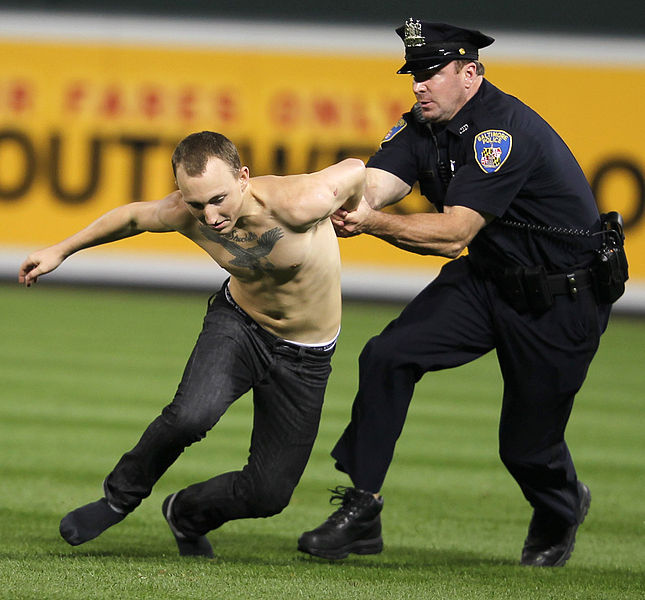Speaking about his role in the film “Tootsie,” actor Dustin Hoffman describes his experience of dressing like a woman, but not looking like a “beautiful” woman:
Speaking about his role in the film “Tootsie,” actor Dustin Hoffman describes his experience of dressing like a woman, but not looking like a “beautiful” woman:
Specific laws criminalizing so-called cross-dressing – – – wearing clothes not appropriate for one’s sex/gender – – – are now relatively rare. Even in the 1970s, courts opined that the very notion of cross-dressing was losing some of its coherency. Meanwhile, other courts were declaring that such laws were unconstitutional as applied to persons they described as “true transexuals.”
Instead, more indirect policing of gender appropriate clothes occurs. For example, a Memphis television station reports that three men were arrested for “prostitution” seemingly based on evidence that they were wearing “provocative female attire.” While the report is somewhat unclear as to whether or not there was other proof of solicitation for commercial sex, the mention of female attire – – – and provocative at that – – – by law enforcement seems to be offered as sufficiently explanatory.
Meanwhile, a photography project by Jon Uriarte has been garnering attention; it consists of full-length portraits of men wearing the clothes of their female partners, “taken in the space shared by the couple.” It’s interesting because it conveys the degree of gender segregation – – – or not – – – in clothing.
And it is also interesting to contemplate which if any of Uriate’s subjects could be charged with prostitution given his attire.
For those wondering how to distinguish between times in which what a female politician wears is irrelevant – – – as in our previous post discussing former Australian PM Julia Gillard- – – and when it might be relevant, Sally Kohn has a particularly good post over at Daily Beast.
Kohn argues, in effect, that Davis’s shoes have become symbolic speech, while most of the time women’s clothes are not speech:
In the sense that Wendy Davis is a hero, her shoes are a symbol—a talisman of feminism and political voice and literally standing up for what’s right. Her shoes are legitimately part of the story of filibustering for 11 hours, especially because they stood out. But pointing out what women leaders are wearing when it has absolutely nothing to do with the story is exactly the opposite—it undercuts the leadership of women and quashes their voice.
While Texas legislator Wendy Davis may not have worn the shoes for their symbolism (merely for their anticipated comfort), they have certainly attained a meaning. If there any doubts, take a look at the “reviews” section for the shoes on Amazon.com.
In London today, women protested the planned Bank of England’s replacement of Elizabeth Fry with Winston Churchill on the £5 note. As reported in The Guardian, the activists were dressed as female historical figures, including Emmeline Pankhurst, and the accompanying headline proclaimed “Campaigners for women on bank notes stage fancy dress protest outside Bank.”
Other than the Queen, the only women to appear on British notes have been Fry and Florence Nightingale.
In the United States, no (actual) woman has appeared on paper money, although there have been several ill-fated coins.
Federal District Judge for the District of Columbia, Amy Berman Jackson, has granted summary judgment for the government in her opinion in Scott v. United States in which Scott had alleged that the United States Supreme Court Police violated clearly established First Amendment principles when they arrested him for unlawful entry while he was wearing a jacket bearing the message “Occupy Everywhere” in the Supreme Court building.
Scott was arrested in January 2012, discussion here; video below:
Since then the federal statute prohibiting certain displays (including words) has been held unconstitutional by a different DC Federal District Judge, at least as to the plaza, and the Supreme Court quickly amended its regulation.
Scott sought damages and expungement of his record, alleging false arrest and imprisonment. Judge Jackson rejected this claim finding that there was probable cause to arrest Scott, and even if there was not, the officers had a reasonable good faith belief that there was probable cause. Jackson concludes that Scott’s jacket “fell squarely” within the plain language of the “display clause” of 40 USC §6135:
he was displaying a device (his jacket) in the building which had been adapted to bring public attention to the “Occupy” movement. See Kinane v. United States, 12 A.3d 23, 25–26 (D.C. 2011) (affirming the conviction of protestors for violating the display clause of section 6135 where the protestors entered the Court with shirts that read, “Shut Down Guantanamo”); Potts v. United States, 919 A.2d 1127, 1130 (D.C. 2007) (holding that an article of clothing can be a “device” within the meaning of section 6135). Since Scott was violating the display clause, he had no authority to remain in the Supreme Court building after the Supreme Court Police told him to cover the display or leave. Therefore, Scott’s violation of section 6135 provided the “additional specific factor” that the Supreme Court Police needed to establish probable cause to arrest him for unlawful entry.
 In Akron, Iowa, a man with a profane tattoo – – – the published image makes it difficult to determine the precise language – – – has been reportedly excluded from the municipal pool unless he covers it.
In Akron, Iowa, a man with a profane tattoo – – – the published image makes it difficult to determine the precise language – – – has been reportedly excluded from the municipal pool unless he covers it.
He claims a First Amendment right to display his tattoo, a claim that has firm First Amendment grounding. In Cohen v. California, decided by the United States Supreme Court in 1971, the Court upheld the right of a person to wear a jacket bearing the phrase “Fuck the Draft.” Cohen was charged with the California crime of tumultuous and offensive conduct causing a breach of the peace, but the Court found that “one particular scurrilous epithet” cannot be excised from public discourse under the First Amendment. The Court opined that “one man’s vulgarity is another’s lyric,” and added that “it is largely because governmental officials cannot make principled distinctions in this area that the Constitution leaves matters of taste and style so largely to the individual.”
The one distinction is that the Akron, Iowa action occurs in a specific place- – – a public pool- – – rather than the more traditional public forum of sidewalks and streets. The Court in Cohen specifically noted that although Cohen was in a courthouse, the law under which he was charged was a general criminal provision. And indeed, the Supreme Court itself polices its own building and grounds with regard to expression, profane and otherwise.
[image via]
Julia Gillard, Australia’s Prime Minister for the last three years and first woman to hold the position, has been ousted by her own party. During Gillard’s tenure, her gender became a focus, including a spotlight on how she dressed and looked.

Julia Gillard as Prime Minister in 2011. Should she really have been wearing white at this citizenship event on Australia Day? And look at that collar! Is the skirt too tight? And less than long sleeves? – – – good thing she is not in Tennessee.
[image of Gillard on Australia Day 2011 via]
This fixation on the attire and appearance of female leaders, including Gillard, was expertly discussed last week by the redoutable and brilliant Anne Summers:
Although male politicians might occasionally have some aspect of their clothes remarked upon—Paul Keating [former Austrailan PM] was criticised for wearing Italian, rather than Australian-made, suits—they never, repeat never, have to endure the banality of the endless sartorial commentary that all women in politics, but especially the leaders, have to deal with. Women leaders need to adopt strategies to try to neutralise this. Hillary Clinton, when she was running for president in 2008 and later as US secretary of state, adopted the pants suit as a virtual uniform. She varied the colour and added accessories such as scarves or jewellery but essentially she, like men in public life, wore the same outfit every day. German Chancellor Angela Merkel has done the same. She has such an array of different coloured jackets, which she wears over black pants, that some wag even created a pictorial representation of a Pantone-style colour chart of her wearing them all and labelled it ‘Fifty Shades of Angela Merkel’. Gillard evidently struggled for a time to vanquish this issue. She has admitted how hard it was for her to face the daily criticism of what she was wearing. This was especially cruel and relentless in her first year in the job when her jackets, especially, were singled out as ill-fitting and badly designed. In April 2013 Gillard commented that she had since worked to make sure her clothes were not an issue. She now has a wardrobe of well-tailored outfits, mostly suits, in solid colours. Wearing them, she exudes the confidence that comes from knowing her ‘look’ is going to emphasise her overall purpose rather than undermine it.
Yet however hard Gillard and other women leaders work to defuse their appearance as a subject of commentary, they cannot escape it altogether.
Summers goes on to discuss the options exercised by other women leaders, including adopting “traditional female dress.” Summers is also worth reading on the consequences of Gillard’s departure.
And if you have never seen Gillard’s “misogyny speech” in Australia Parliament, it’s definitely worth watching. She wore blue.
 With the widespread news that the town of Wildwood, New Jersey has adopted a dress code for its boardwalk, despite its questionable constitutionality, at least one politician in Ocean City, Maryland reportedly thinks that town should do the same.
With the widespread news that the town of Wildwood, New Jersey has adopted a dress code for its boardwalk, despite its questionable constitutionality, at least one politician in Ocean City, Maryland reportedly thinks that town should do the same.
The so-called “decency law” would criminalize the way people dressed. The law is reportedly prompted by the desire to prevent crimes and violence, but the logical link between the way people dress and the way people rob others is weak. If a man is shirtless, does that mean he is a mugger? And if he is, does wearing a shirt mean he will not steal?
Here’s more on the (unconstitutionality) of government attempts to make men wear shirts or not “sag” their pants displaying their underwear and there’s more in the book, Dressing Constitutionally.
[image via]
The bill, C-309, was a “private member’s bill” originally proposed by a Conservative MP in 2011. It passed both Houses of Parliament and was accorded Royal Assent on June 19, thus becoming law.
Entitled “Preventing Persons from Concealing Their Identity during Riots and Unlawful Assemblies Act,” it amends the riot provision, §65, to include a new subsection:
Every person who commits an offence under subsection (1) while wearing a mask or other disguise to conceal their identity without lawful excuse is guilty of an indictable offence and liable to imprisonment for a term not exceeding 10 years.
And similarly amends the unlawful assemblies provision, §66, to include a new subsection:
Every person who commits an offence under subsection (1) while wearing a mask or other disguise to conceal their identity without lawful excuse is guilty of
(a) an indictable offence and liable to imprisonment for a term not exceeding five years; or
(b) an offence punishable on summary conviction.
The Criminal Code elsewhere defines an unlawful assembly as “three or more persons” who disturb the peace “tumultuously” (§63) and a riot as an “unlawful assembly that has begun to disturb the peace tumultuously” (§64).
The bill – – – now law – – – seems targeted at specific protests; the sponsor reportedly had specific urban “riots” in mind.
In the United States, the majority of states have anti-masking statutes, a few of which are specifically linked to protests. For example, New York’s criminalization of “loitering while masked” was used to charge protestors at “Occupy Wall Street” actions. Such laws, especially when applied during protests, are subject to First Amendment free speech challenges. Clearly, to the extent that the “mask” is a component of the expression, it should be insulated from criminal consequences by free speech protections.
The policy banning “gang insignia and garb at the Marin County Fair is reportedly being called racially discriminatory by the Northern California ACLU.
In addition to statistical evidence about the racial and age characteristics of persons usually targeted, the very notion of what constitutes gang attire or insignia is constitutionally fraught. There is little consensus among statutes, policies, law enforcement, and academics about the indicia of gang membership or even what constitutes a gang. Are the fans of Insane Clown Posse a gang? (The FBI once decided they were, but changed its mind). And is wearing the color blue or sportsgear or having a tattoo with one’s nickname sufficient proof of gang membership?
And, intriguingly, who decides what constitutes gang attire? Common knowledge? Police officer testimony? An outdated handbook?
The Ninth Circuit Court of Appeals considered a challenge to an anti-gang dress code by members of the “Top Hatters,” who were escorted off the grounds of the Gilroy Garlic Festival, not so far from Marin County. The offending attire was vests that included an image of a skull with wings and a top hat with the words “Top Hatters” above the top hat and the word “Hollister” written below. Despite the fact that an on-duty police officer “escorted” the vest-wearers off the festival grounds, the Ninth Circuit ultimately held in Villegas v. Gilroy Garlic Festival that the festival was not governmental, and thus the Top Hatters could not claim any constitutional rights. This does not seem to be the case with Marin County.
However, the lower court in the Garlic Festival case also struggled with whether the Top Hatters had a First Amendment claim of “speech” asking whether the badge on their vests was conveying a generally understood message? This “catch-22” – – – that the person must prove that their dress conveys a message even as the state is seeking to ban that message – – – can complicate First Amendment challenges to bans on gang attire.
These First Amendment claims often merge with Due Process claims. The United States Supreme Court has declared unconstitutional Chicago’s city ordinance criminalizing loitering by gang members. On the other hand, the California Supreme Court has upheld a prosecutorial injunction banning gang members from wearing clothing bearing specific numbers, although it limited the ban to “the conscious expression of gang affiliation, support and allegiance.”
But race combined with age and gender are overriding factors in the construction of “gang” and “gang membership.” For example, in Los Angeles, almost half of African-American men between the ages of 21-24 were listed on the gang database; since most did not have criminal records, presumably these men favored gang attire. In Minnesota, with a population that is approximately five percent African-American, a 2009 report notes that African-Americans represented approximately half of the persons listed in the gang databases. The report also expressed community concern that the criteria for inclusion in the database highlighted “factors” – – – including attire and tattoos – – – “that are synonymous with the urban youth culture.”
In short, how can Marin County be sure it is not simply banning a style?
[ image via]